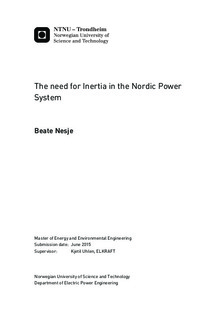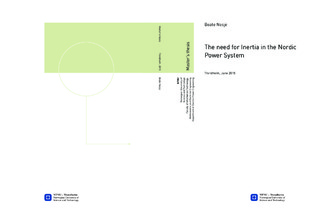| dc.description.abstract | The Nordic power system is changing towards an increasing share of new renewable power sources. Conventional power sources contribute with a large amount of kinetic energy in the system due to their synchronously connected generators. This saves the system from large frequency deviations the first seconds after a power imbalance in the system. This kinetic energy is referred to as the system inertia. Wind power and HVDC do not have their kinetic energy connected directly to the system frequency like the conventional power sources.
Nuclear and thermal power plants contribute with large reserves of kinetic energy. Hydropower contributes with a smaller amount of kinetic energy, but contributes with frequency containment reserves that are activated seconds after a disturbance. Both frequency containment reserves and system inertia are crucial to avoid large frequency deviations after a large power imbalance.
This thesis mainly focuses on the dynamic response after a disturbance. The system operators have several requirements for the frequency response and the power response after an outage occurs. The main part studied in this thesis is the maximum frequency deviation in the transient period, and the fastness of the system to provide extra energy.
This thesis studies the frequency stability in low load scenarios for the Nordic synchronous system, which includes Norway, Sweden, Finland and eastern Denmark. A model made in Simulink, which excludes voltage stability, rotor angle stability and load flow, investigates the balance between mechanical power and electrical load after a disturbance. It is assumed that the generation and the load are equal. The model was tuned based on a real response from an outage in the Nordic synchronous area.
The dimensioning incident in the Nordic power system today is 1400 MW. This means that the system should withstand a fault of this size, and still be able to operate within the requirements set for power response and frequency response. The simulations show that this can be challenging in several of the low-load scenarios.
There are two main scenarios, the first with conventional power sources. This is a scenario from an early morning in June 2013. The second scenario has large integration of wind power, HVDC and small-scale hydropower. Statnett has developed this worst-case scenario for 2020. Both scenarios have a total production of about 20 000 MW.
The first scenario shows that with a 50 percent share of hydropower, the system can only withstand an outage of 1300 MW maximum, with a large proportional gain in the hydropower governor.
The future scenario shows that synthetic inertia can make a large contribution to the system stability. With a well-tuned synthetic inertia contribution, the system will be able to withstand an outage of 1400 MW during low-load scenarios.
Some of the main findings are as follows:
A. Synthetic inertia is shown to have great effect on the frequency response in the transient period. It provides active power supply after a disturbance without contributing to reduce the frequency.
B. For a system at low load, the maximum frequency deviation is often at a critical point after a disturbance of the active power balance. This problem must therefore be addressed differently than today. Today, the frequency containment reserves are purchased and it is assumed that the system inertia is sufficient. This is shown not to be the case.
C. To minimize the frequency deviation in the transient period, an active power supply like FCR and synthetic inertia is more efficient to apply to the system than a higher amount of system inertia. | |

